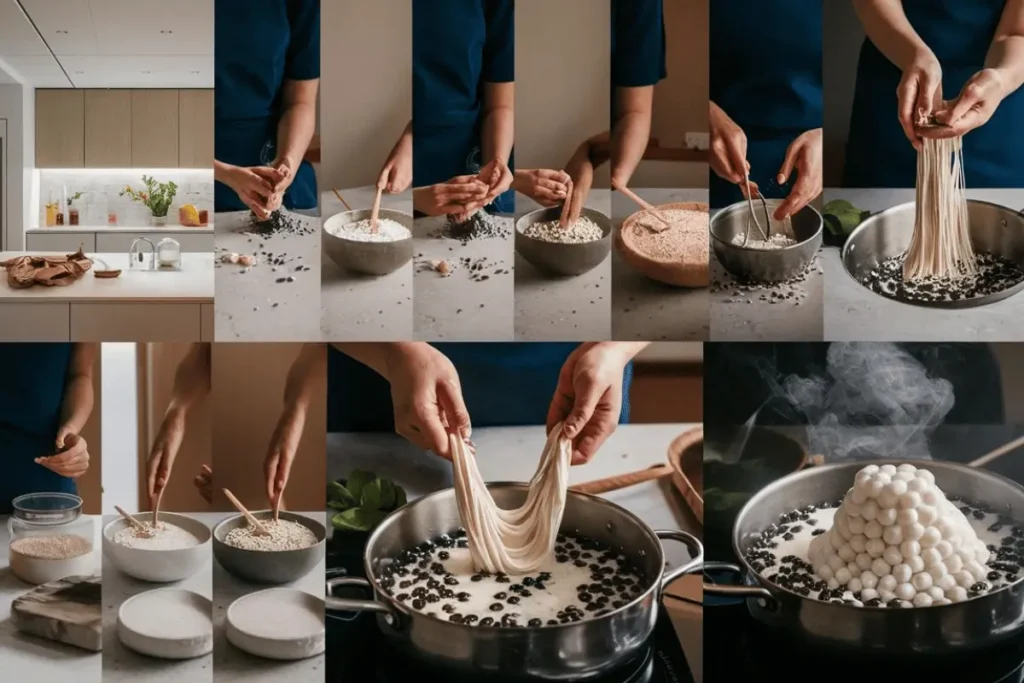Tapioca pearls, those small, chewy spheres crafted from the starch of cassava roots, have captured the culinary imagination of food enthusiasts worldwide. Not only do these pearls boast a unique texture, but they also exhibit remarkable adaptability, making them a favorite ingredient in various dishes across multiple cuisines. Whether you’re crafting the perfect bubble tea or adding a surprising element to savory meals, tapioca pearls have the power to transform ordinary recipes into something extraordinary. In this comprehensive guide, we’ll explore the origins, uses, and recipes that feature this versatile ingredient, ensuring you can confidently use tapioca pearls in your kitchen.
What Are Tapioca Pearls?
Culinary experts create these chewy balls from tapioca starch, which they extract from the cassava root, a plant native to South America. Although tapioca pearls typically start out white or off-white before cooking, chefs often dye or flavor them to take on various colors and tastes. For instance, black pearls, the most popular type, gain their color from brown sugar or caramel added during the manufacturing process.
While many people associate tapioca pearls primarily with bubble tea, they are actually used in a wide array of dishes, from desserts to savory meals. Therefore, their versatility offers endless possibilities in the kitchen.
The History Behind Tapioca Pearls
The history of tapioca pearls closely follows the global spread of cassava, the root from which tapioca starch comes. Originally cultivated by the indigenous peoples of South America, cassava made its way to Africa and Asia in the 16th century. This migration occurred due to Portuguese and Spanish explorers who introduced the plant to these regions. Its ability to thrive in various climates quickly made it a staple crop in many countries.
Interestingly, it wasn’t until the 1980s in Taiwan that tapioca pearls gained worldwide fame. They became a key ingredient in bubble tea, a drink that has since taken the world by storm. As bubble tea’s popularity grew, so did the recognition of tapioca pearls as a versatile ingredient.
Culinary Uses of Tapioca Pearls
Tapioca pearls are celebrated for their adaptability, lending themselves to a broad spectrum of culinary applications. Therefore, it’s no surprise that they have found a place in both traditional and contemporary dishes. Below are some of the most popular ways to incorporate them into your cooking.
1. Bubble Tea
Bubble tea remains the most iconic use of tapioca pearls. This refreshing beverage, which blends tea, milk, and sweetened pearls, has become a global sensation. The chewy texture of the pearls provides an enjoyable contrast to the smooth tea, making it a fun and satisfying drink.
Recipe: Classic Bubble Tea
Ingredients:
- 1 cup black pearls
- 2 cups water
- 2 cups brewed black tea, chilled
- 1/4 cup sugar syrup (or to taste)
- 1/2 cup milk (or any milk alternative)
- Ice cubes
Instructions:
- Cook the Pearls: To begin, boil water in a medium saucepan. Next, add the pearls and stir gently to prevent them from sticking. Cook for about 15 minutes until the pearls become fully translucent and chewy. Afterward, drain and rinse them under cold water.
- Prepare the Sugar Syrup: In a small saucepan, combine sugar with water (1:1 ratio) and heat until the sugar completely dissolves. Once dissolved, let it cool.
- Assemble the Bubble Tea: First, divide the cooked pearls between two glasses. Then, add sugar syrup to taste. Pour in the chilled tea and milk, and finally, add ice cubes and stir well.
- Serve: Serve and enjoy your homemade bubble tea with a wide straw to sip up the pearls!
2. Tapioca Pudding
Tapioca pudding, a classic dessert cherished by many, has been enjoyed for generations. Made by cooking small pearls in milk and sweetening them with sugar, this dessert results in a creamy, comforting dish with a distinctive texture.
Recipe: Creamy Tapioca Pudding
Ingredients:
- 1/2 cup small pearls
- 2 cups milk
- 1/2 cup sugar
- 1/4 teaspoon salt
- 1 teaspoon vanilla extract
- 1 egg (optional, for a richer pudding)
Instructions:
- Soak the Pearls: Begin by soaking the small pearls in water for about 30 minutes. After soaking, drain them well.
- Cook the Tapioca: Next, combine the soaked pearls with milk, sugar, and salt in a saucepan. Cook over medium heat, stirring frequently, until the mixture comes to a gentle boil.
- Add Egg (Optional): If you prefer a richer pudding, beat an egg in a small bowl. Slowly add a few spoonfuls of the hot mixture to the egg, stirring constantly to temper it. Then, pour the egg mixture back into the saucepan and continue cooking until the pudding thickens.
- Finish and Serve: Finally, remove the pudding from heat, stir in the vanilla extract, and let it cool. Serve warm or chilled, depending on your preference.
3. Savory Dishes
While tapioca pearls are often associated with sweet treats, they can also bring an interesting texture to savory dishes. In some cultures, cooks use them to enhance soups or as a thickening agent in stews and sauces.
Recipe: Tapioca Pearl Dumplings

Ingredients:
- 1 cup tapioca pearls
- 1/2 pound ground pork
- 1/4 cup finely chopped onions
- 2 cloves garlic, minced
- 1 tablespoon soy sauce
- 1 tablespoon fish sauce
- Salt and pepper to taste
- Banana leaves (for steaming, optional)
Instructions:
- Soak the Pearls: First, soak the pearls in water for about 2 hours until they become soft and pliable.
- Prepare the Filling: Brown the ground pork in a skillet over medium heat. Then, add the onions and garlic, and sauté until fragrant. Stir in soy sauce, fish sauce, salt, and pepper. Once done, allow the filling to cool.
- Form the Dumplings: To form the dumplings, flatten a small amount of soaked tapioca in your hand. Place a spoonful of the pork filling in the center and wrap the tapioca around it to form a ball. Repeat this process with the remaining ingredients.
- Steam the Dumplings: Place the dumplings on banana leaves in a steamer. Steam for about 15 minutes until the tapioca turns translucent and the filling is heated through.
- Serve: Finally, serve the dumplings with a dipping sauce of your choice.
4. Creative Desserts
Tapioca pearls can also add a fun, chewy texture to various desserts, enhancing everything from fruit salads to yogurt, or even becoming part of cakes and pastries.
Recipe: Tropical Fruit Salad with Tapioca Pearls
Ingredients:
- 1/2 cup small pearls
- 1 cup coconut milk
- 2 tablespoons sugar
- 1 ripe mango, diced
- 1 ripe banana, sliced
- 1/2 cup pineapple chunks
- 1 tablespoon lime juice
- Fresh mint leaves (for garnish)

Instructions:
- Cook the Pearls: First, bring a pot of water to a boil, add the pearls, and cook until they become translucent. After cooking, drain and rinse under cold water.
- Prepare the Coconut Dressing: Next, heat the coconut milk with sugar in a small saucepan until the sugar dissolves. Once dissolved, let it cool to room temperature.
- Assemble the Salad: In a large bowl, combine the cooked pearls with the diced mango, banana, and pineapple chunks. Drizzle with lime juice.
- Add Dressing: Pour the coconut milk dressing over the fruit and tapioca mixture. Toss gently to combine.
- Serve: Garnish with fresh mint leaves and serve chilled for a refreshing treat.
Tips for Perfect Tapioca Pearls
Cooking tapioca pearls can be tricky, especially for beginners. However, with the right tips, you can achieve perfect results every time. Here are some key points to keep in mind:
- Use Ample Water: Tapioca pearls require plenty of water to cook properly. Therefore, use at least 6 cups of water for every cup of pearls.
- Stir Frequently: To prevent the pearls from sticking together, stir them frequently while cooking.
- Cook Until Fully Translucent: The pearls are ready when they become translucent all the way through. If you still see white spots in the center, continue cooking.
- Rinse After Cooking: After cooking, rinse the pearls under cold water to stop the process and remove excess starch.
- Store Properly: If you’re not using the tapioca pearls immediately, store them in a sugar syrup to keep them from sticking together. They can be kept at room temperature for a few hours.
Exploring Global Variations
Different cultures around the world have incorporated tapioca pearls into their traditional dishes, each with a unique twist. In India, for example, “sabudana khichdi” is a popular dish made with small pearls, peanuts, and spices. Often enjoyed during fasting periods, this dish is a staple in many households.
In Brazil, tapioca pearls take on a different form in “sagu,” a dessert where the pearls are cooked in red wine or grape juice. This dish is often served as a sweet treat after meals.
Meanwhile, in Southeast Asia, tapioca pearls are a key ingredient in “bubur cha-cha,” a sweet, coconut milk-based dessert that also includes a mix of sweet potatoes, yams, and taro. The pearls add a delightful chewiness to the creamy, rich dessert.
Modern Culinary Uses
In recent years, chefs and food enthusiasts have started experimenting with tapioca pearls in modern and unexpected ways. As a result, these chewy gems have found their way into molecular gastronomy, where they create unique textures and flavors in avant-garde dishes.
For example, some chefs use tapioca pearls as a base for caviar-like toppings, infusing them with flavors like balsamic vinegar or soy sauce. Meanwhile, others incorporate them into ice creams and sorbets, where their chewy texture provides a surprising contrast to the creamy base.
Conclusion
Tapioca pearls are a culinary treasure, offering versatility and fun in a multitude of dishes. Whether you’re making a classic bubble tea, a comforting pudding, or exploring new culinary frontiers, tapioca pearls are an ingredient worth mastering. With their unique texture and ability to absorb flavors, they bring a special touch to any dish. So, the next time you’re in the kitchen, consider the many possibilities that tapioca pearls offer and let your creativity flow.
